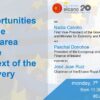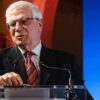Global infrastructure strategies are essential on the frontlines of geopolitical competition. China launched its Belt and Road Initiative (BRI) back in 2013 and the Biden-Harris Administration did so with its Build Back Better World (B3W) in June 2021. Therefore, it is welcome news that the EU has entered the game with the recently announced Global Gateway in December 2021. This is confirmation that the Union is finally developing some strategic muscle with an integrated and holistic approach on how its economic diplomacy should operate in an era of great-power rivalry.
“Ultimately, the EU’s Global Gateway aim must be to make democracies deliver on today’s global challenges.”
Raquel Jorge & Miguel Otero
Today, engagement in third countries is not only key to winning contracts and gaining market share, but also to guarantee common development goals and values at a time when security and resilience are paramount for the global economy and its vital supply chains. For this same reason, the focus of the Global Gateway on investment in digitalisation and technology is particularly suited. Ultimately, the EU’s Global Gateway aim must be to make democracies deliver on today’s global challenges. However, to achieve this goal, the proposal –as it stands now– opens up several questions in need of answers.
The first issue is the size of the budget. The commitment to mobilise investments of up to €300 billion (most of it a repackaging of previously committed funds) over the 2021-27 period falls short compared with Beijing’s Belt and Road Initiative, whose annual funding –at a minimum US$100 billion yearly– outcompetes the Global Gateway’s. Meanwhile, to match China’s influence, the US-proposed B3W has committed to ‘collectively, together with the private sector, US stakeholders, and G7 partners, to catalyse hundreds of billions of dollars in the coming years’. In fact, the EU’s Global Gateway points out that it will partner with like-minded countries and allies.
Nonetheless, these figures can be misleading. The EU and its member states are the world’s largest development donors. As Simone Tagliapetra has pointed out, by counting only the grants the EU’s funding is already larger than the BRI’s. The aim of the Global Gateway should be to become the strategic umbrella to deploy these massive, but dispersed, funds more effectively.
By doing so the Global Gateway can become a frontrunner in the coherence of the EU’s external action. The Union has already reduced its fragmentation by combining its funding for the neighbourhood and international development into a unique instrument (NDICI), and by launching the ‘Team Europe’ package, which mixes resources from the EU, EU countries, the European Investment Bank, and the European Bank for Reconstruction and Development. In this line, the EU may revamp its global presence if it redefines its strategic governance model so as to focus on infrastructure projects that are aligned with the Union’s strategic goals. To do so it needs to think through the deployment of which assets, with whom and through which procedures.
The Global Gateway announcement points out that ‘equal partnerships’ will be developed ‘at eye-level’, taking into account the capacity of host countries to manage and maintain the infrastructure in a sustainable way after it has been completed. Again, the focus of building infrastructures that can outlast the development funding of the EU is welcome. This approach of ‘sum of projects’ aligns with the 2021 EU’s Foresight Report, which clearly acknowledges that in the future there will be no single player in a position to dominate all regions and policy domains. Partnerships need to be developed, but they need to be strategically thought through, with a clear hierarchy of priorities and long-term commitments.
Thus, the Union should plan how it will proceed with the ‘exit strategy’ in each project and how to build up a mutual trust that it would do well to reinforce through cooperation on key topics at the global scale. This means making host countries able to maintain their own infrastructures once the project is completed. But it also means that the Union needs similar guidelines on how it aims to guarantee its projection geopolitically as a close partner in the long term. This will have a significant impact on potential coalition-building for pressing topics at the multilateral level and also on how the EU can move some topics up the chain of international agendas.
In this respect, the Global Gateway is a good starting point to develop a coordinated strategy by ‘Team Europe’, not only as a policy-oriented framework, but also as one of high-level political momentum. The Union can take advantage of this new strategy and try to create a greater internal cohesion while strengthening ties with third countries in order to guarantee mutual trust and coalition-building in the long term and on a global scale. This means that the EU needs to follow up on the political agenda that the Global Gateway proposes for the Indo-Pacific, Eastern European partners and the African Union.
However, it should not overlook the importance of other regions for which there is still no regional strategy, such as Latin America and the Caribbean, into its existing cooperation mechanisms, especially as regards connectivity and digitalisation, or the Gulf Strategy, although the EU’s 2022 Action Plan foresees a new strategy for the latter region.
“(…) Europe’s open strategic autonomy will only be genuine if access to raw materials and rare earths through external partnerships is guaranteed.”
Raquel Jorge & Miguel Otero
In the case of Latin America and the Caribbean, alongside the undersea cable BELLA programme and the recently announced Digital4Development (D4D) hub, there are opportunities in other largely uncharted technology areas. Specifically, the expected uptake of 4G and 5G broadband is still low. The former is to increase by 67% in 2025, and the latter will spread out across only 12% of the LAC territory by the same year. There is also a need for greater cooperation in bridging the digital skills gap, not only in rural areas but also in large cities where a specialised workforce is lacking, as well as in the education system. This might revamp the presence of European companies and tech competitiveness, including green technology, across the Latin American and Caribbean regions.
While the Global Gateway accurately defines these technology areas and commits efforts to them, there are still two issues that should be addressed for the digitalisation pillar. First, critical raw materials and rare earths should be part of the strategy, including the digitalisation priority. The Commissioner for the Single Market, Thiérry Bréton, has warned that Europe’s open strategic autonomy will only be genuine if access to raw materials and rare earths through external partnerships is guaranteed. This touches on the need to produce permanent magnets, essential for the automobile industry, and also in the aerospace industry and in technological defence capabilities. Other technologies –robotics, 3D printing and green tech– also rely on raw materials from regions whose supply risk level is low or very low, according to the European Commission. In this respect, the EU needs to address how it will partner with the countries of origin of these raw materials such as Brazil (niobium), Chile (lithium) and Mexico (fluorspar), all countries on which the EU depends for certain technology manufactures.
The second issue is how the Global Gateway will link these infrastructure projects digitally around the world with its own European companies. Some European factories of semiconductors are being revamped –like ‘Silicon Saxony’ in East Germany– while others focus on knowledge creation –as with IMEC in Belgium–, but the amount of companies working on design, manufacturing and supply is limited to only a few –such as the Dutch firm ASML–. Some EU member states have started cooperating with non-EU companies to fill their supply chains: returning to the example of semiconductors, the US company Intel Corp invested up to €80 billion in Europe to boost chip capacity in plants in Ireland and Germany. Thus, one of the challenges for the Global Gateway is to define the scope of cooperation between endogenous and foreign companies to deploy these projects in third countries, especially in the Global South. If European money ends up in the pockets of US and Chinese firms, the EU’s strategic autonomy will certainly not be enhanced.
The Global Gateway is undoubtedly an opportunity for the EU. While there are some issues to be addressed, the EU has embarked on a strategic project which, if successful, will allow the region to stretch its projection as a peer and ally to third countries. This is not only about market power: it is also about security and values. The challenge for the Global Gateway now is to equip its governance mechanisms adequately, avoid overlapping with previously existing mechanisms or initiatives in specific priority areas, and make Team Europe a well-oiled machine that can guarantee that policy-oriented development projects on the ground are well matched with the high-level political momentum the initiative has received from the offices of power in Brussels and Europe’s national capitals.
Image: 3d illustration of a sphere with blue balls floating above it and interconnected. Photo: Shubham Dhage




